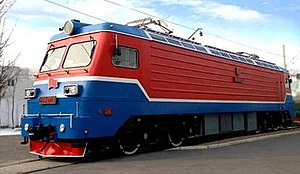| Sŏngun Red Flag | |||||||||||||||||||||
|---|---|---|---|---|---|---|---|---|---|---|---|---|---|---|---|---|---|---|---|---|---|
 Sŏngun Red Flag number 0001 at its rollout ceremony in 2011 | |||||||||||||||||||||
| |||||||||||||||||||||
| |||||||||||||||||||||
| |||||||||||||||||||||
| |||||||||||||||||||||
| [1] | |||||||||||||||||||||
The Sŏngun Red Flag ( Korean: 선군붉은기, Sŏngun Pulg'ŭn'gi) class is a group of electric locomotives manufactured by the Kim Chong-t'ae Electric Locomotive Works for the Korean State Railway.
Description
On 5 January 2011, the Korean Central News Agency announced that an unveiling ceremony had taken place for a new electric locomotive built by the Kim Chong-t'ae locomotive factory for the Korean State Railway. The primary design goal was to create a locomotive that produces higher power output with lower power usage. [2]
Given the Sŏngun Red Flag class name by Kim Jong Il (much like the prototype of the Red Flag 1 locomotive was given its name by Kim Il Sung), [2] the new locomotive is the first to be built in North Korea with asynchronous motors. [3] Intended for use on freight trains in mountainous areas, [3] it has a continuous power output of 2,000 kilowatts (2,700 hp), [4] resulting in a tractive effort nearly 1.5 times that of the Red Flag 1 class, while consuming 50% less power. [2]
The twin-cab body rides on two two-axle, self-steering bogies with a computerised braking system. [2] It is equipped with a computerised operation control system with four LCD display screens in each cab. [5] Although the KCNA report claimed that this was developed domestically, the control system is made by CNR Dalian in China. This is also the case with the asynchronous motors, which are actually Chinese-made Xiangyang induction motors. [4]
Numbered in the 0000 series, the prototype was painted in a special red and blue paint scheme, but production versions are painted in a variant of the new standard light green over dark green livery; this also differs from the prototype in some details, such as the fluting on the sides and the shape of the upper headlamp. [6] At least one production unit has been seen numbered in the 4000 series (4071); [7] this series is allotted to the Ch'ŏngnyŏnjŏl Kinyŏm-class class, although the highest known number assigned to one of those locomotives is 4056; this could mean that production units are now being numbered from 4070. The prototype has been used for a number of special events, including a ceremony in which Kim Jong Il inspected the prototype, saying that "production of modern railway vehicles is important to our railway modernisation policy." [2] and the opening of the Songdowŏn Line on 23 September 2014 was marked by a special inaugural train pulled by the prototype. [8] One of the production locomotives has been deployed to the Sinuiju Locomotive Brigade. [9]
References
- ^ "3大革命展示館". Retrieved 30 September 2021.
- ^ a b c d e 우리 나라에서 최첨단교류기관차 개발 (in Korean)
- ^ a b 북한 순수 기술의 선군붉은기 1호와 각종 북한기차들 (in Korean)
- ^ a b 朝鲜铁路机车车辆概况一览 (in Chinese)
- ^ 朝鲜铁路机车车辆概况一览(续) (in Chinese)
- ^ http://dprk114514.blog.fc2.com/blog-category-1.html[ permanent dead link]
- ^ http://www.nordkorea-info.de/images/Universitaet-fuer-Eisenbahnwesen-Pyongyang-2016-06-B.jpg [ bare URL image file]
- ^ 北, 원산 송도원국제소년단야영소에 송도원역 준공, Nocutnews, 2014.9.24 (in Korean)
- ^ "기관차의 실동률을 높이기 위한 사업 힘있게 전개". arirangmeari.com. Retrieved 2021-09-30.